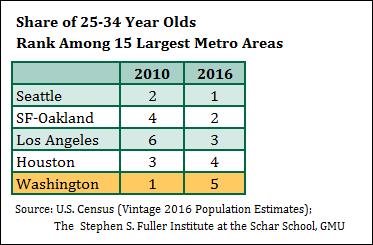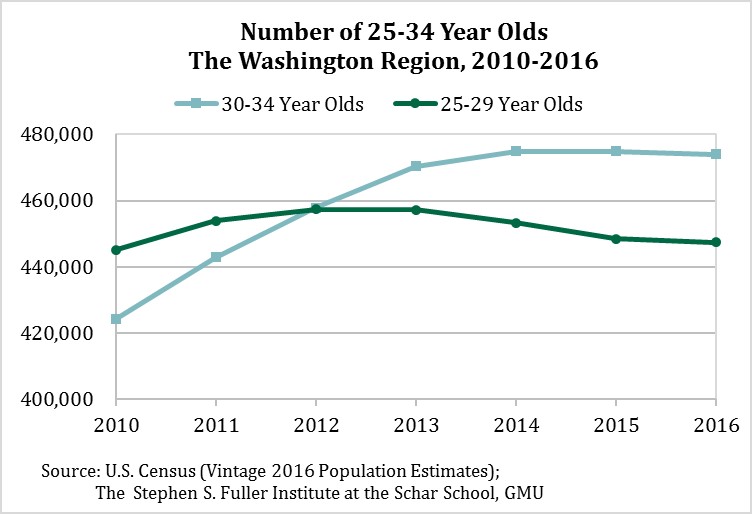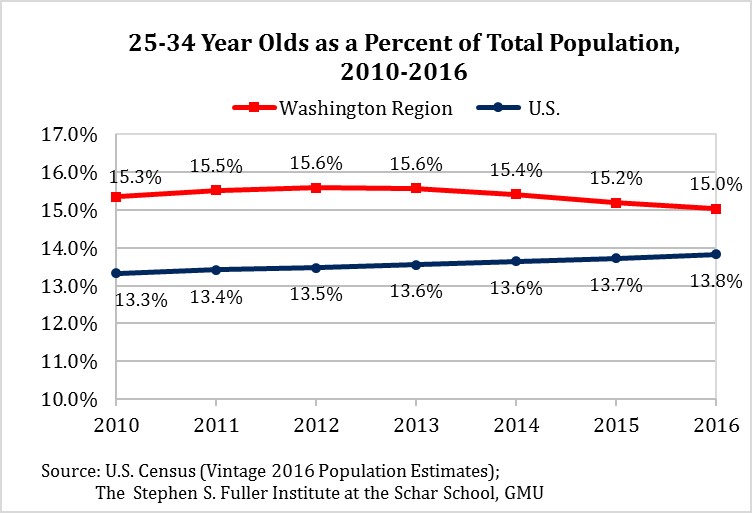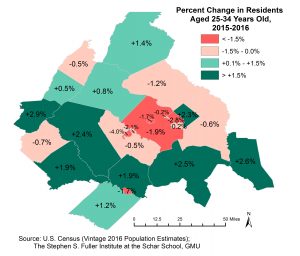From The Washington Business Journal:
Greater Washington is slipping when it comes to attracting and retaining younger workers.
In 2016, the region added 53,508 people, about 0.9 percent growth, but most of that came from older populations, according to data from the Stephen S. Fuller Institute at George Mason University. Greater Washington actually lost about 2,000 people aged 25 to 34 from 2015 to 2016, considered to be a crucial demographic for future growth.
“This is the new blood. If it looks like we are not gaining, then it has broader implications for where our workers are coming from in the future,” said Jeannette Chapman, deputy director and senior research associate at the institute.
So here’s what is happening:
- There have been multiple years of declines now, which is a big reversal from the substantial growth in young people the region saw immediately following the recession.
- This new trend runs counter to national trends as the 25-to-34 age group increases in size nationwide. It also runs counter to almost every other large metro area in the last few years — 13 of the 15 largest metro areas grew its share of this demographic.
- These two data points together suggest that the Washington region is becoming less attractive to young people as they decide where to move. And it means the region is less able to hold on to younger people as they move out.
That demographic shift can cost the region. Younger people help drive growth in local amenities, such as restaurants and stores, and contribute to the local economy through their spending, as well as providing the backbone of the future workforce.
Not to mention, it’s much harder to convince people in their 40s or 50s to relocate to another region.
“They have been fueling some of the amenity and activity boom that has occurred in select areas around the region,” Chapman said. “That isn’t to say the small decrease will kill that boom but it will make it harder to grow.”
The data are just the latest in a series that signal slowing growth and potential problems down the road for Greater Washington. In March, the institute released data showing that more people are leaving Greater Washington than moving to it domestically — international immigration supplies the net population growth. More recently, it detailed how the region’s economic standing relative to its peer cities was on the decline.
Greater Washington saw a big increase in younger residents immediately following the recession because of its combination of good, high-paying jobs and access to amenities. But as housing costs continue to rise and affordability drops, and the region continues to produce fewer of those quality jobs, it only becomes less attractive, according to Chapman.
Only time will tell if this is a short-term blip or a long-term trend that drives the regional economy going forward, Chapman said.
“Our pull factor that used to be related to job growth has weakened,” she said. “It may not change every person’s decision, but it does start chipping away at the numbers.”
View the full story ›
Copyright Washington Business Journal, reprinted with permission
Graphics from the story:




